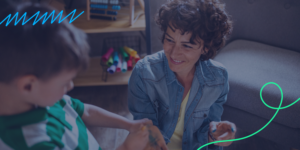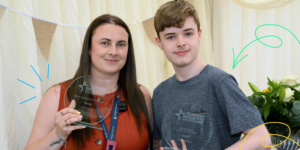Communication isn’t just about talking or the words that we use; it incorporates body language, signs, symbols, and other supportive techniques that help us ensure that we are understood. There are around 1.5 million people in the UK with a learning disability, and for some of those people, communication and processing of information can sometimes be difficult.
There are different tools and strategies available that provide people with the opportunities and empowerment to express themselves more freely, ensuring that they can connect with the world around them and help them to be understood. From augmentative and alternative communication (AAC) devices to visual aids and tailored therapies, there are plenty of tools at our disposal that support us to better communicate with the people we support and encourage them to share their thoughts, feelings, and experiences.
Makaton
Makaton uses a combination of signs, symbols, and speech to help people communicate; it combines visual aids with spoken words to enhance understanding and expression.
By using simple, structured gestures alongside speech, individuals can gradually build their confidence and skills in communicating both non-verbally and verbally. For many, Makaton provides a bridge between silence and self-expression, offering a powerful tool that respects the individual’s pace and abilities.
On the Makaton website, they have a range of resources and a ‘word of the week’ that provides support for families and loved ones wanting to learn and integrate it into their day-to-day life.
Speech and Language Therapies
At Bright Futures, we value taking a person-centered and holistic approach to care and education. We work with external specialist training providers offering speech and language therapies alongside our in-house Specialist Support Team.
Working alongside Shine Therapy and SpeechWise, our person-centred approach explores therapy techniques that support the development of speech and language skills. These therapies can use a range of methods to support communication development, even utilising some that we cover in this blog.
They look at things like attention and listening, the meaning of certain words and their context, communication in social settings, pronunciation and other barriers to communication. It’s about finding solutions that make a difference to the lives of the people we support and setting them up for a bright journey ahead.
Easy Read Materials
Creating ‘Easy Read’ materials support people to access, understand and digest information and is key in supporting people with autism and learning disabilities to actively participate in the world around them.
These materials use short sentences, larger font size, and relevant easy to understand words and pictures to help break down important information like forms, reports, and instructions to name just a few.
We often create Easy Read versions of our materials to empower the people we support to make choices, ask for help, and become more independent. It supports the understanding of certain safety procedures across our homes and schools and can be used in so many ways to give them more choice and control over their own lives. There are plenty of Easy Read resources already available on websites like Mencap.
Augmentative and Alternative Communication (AAC) Devices
Speech Generating Devices
Developing technology has given us access to AAC devices and communication apps. Using pictures and symbols to help identify the words, the people we support can form phrases and sentences at the touch of a button. These sentences are then read out by the device giving individuals with autism the opportunity of independent and spontaneous conversation.
We use LAMP (Language Acquisition through Motor Planning) devices on ipads and tablets that are personalised to the people we support. With these devices, the people we support can communicate whatever is important to them, express their hopes, wants and needs and shape the care and support that they receive.
You can read more on the Language Acquisition through Motor Planning (LAMP) approach in one of our previous blogs ‘LAMP Words for Life’ here. Working in partnership with Liberator across both our Care and Education offering has supported a number of people that we support to benefit from the language development and support that comes with assistive technology.
Picture Exchange Communication System (PECS)
As the name suggests, this form of communication teaches the exchange of pictures for things that people want. For example, if someone we support wants to go and play in the garden, they will show that relevant picture to their care or education team. This is a great tool for initiating communication, especially for those who do not use verbal language to communicate.
You might notice that some of our teams have visual symbols attached to their company ID lanyard, and this is to help support those ongoing conversations using symbols while on the go. Our teams have shared some of these resources to parents of our students at School too – to keep up consistency and support no matter where they are.
At Bright Futures, our teams work closely with the people we support and get to know the individual tools and techniques that work for each person, which can change as they progress and grow. Our people continue to learn and develop their understanding of certain communication tools, with relevant training from our internal and external specialists.
We strive for better for the people we support, finding communication techniques that work for them opens up those person-centred opportunities and enhances their overall quality of life.





